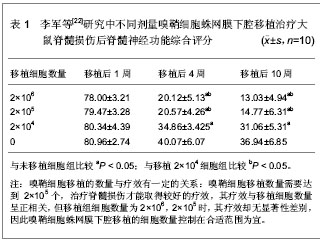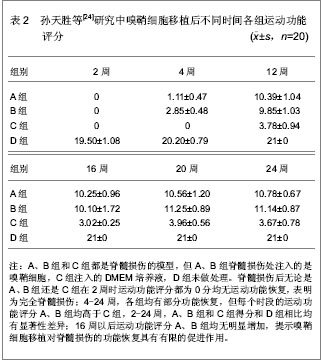| [1] Corti S,Locatelli F,Papadimitriou D,et al.Somatic stem cell research for neural repair: current evidence and emerging perspectives.J Cell Mol Med.2004;8(3):329-337.[2] Skinner AP,Pachnicke S,Lakatos A,et al.Nasal and frontal sinus mucosa of the adult dog contain numerous olfactory sensory neurons and ensheathing glia.Res Vet Sci.2005; 78(1):9-15.[3] Barnett SC,Chang L.Olfactory ensheathing cells and CNS repair: going solo or in need of a friend?Trends Neurosci. 2004;27(1):54-60.[4] Radtke C,Lankford KL,Wewetzer K,et al.Impaired spinal cord remyelination by long-term cultured adult porcine olfactory ensheathing cells correlates with altered in vitro phenotypic properties.Xenotransplantation.2010;17(1):71-80.[5] Li Y,Field PM,Raisman G.Repair of adult rat corticospinal tract by transplants of olfactory ensheathing cells.Science. 1997; 277(5334):2000-2002.[6] Senior K.Olfactory ensheathing cells to be used in spinal-cord repair trial.Lancet Neurol.2002;1(5):269.[7] 黄红云,王洪美,陈琳,等.嗅鞘细胞移植治疗晚期脊髓损伤临床试验初步报告[J].立体定向和功能性神经外科杂志,2004,17(6): 348-350.[8] 中国知网.中国学术期刊总库[DB/OL].2013-3-27. https://www.cnki.net[9] SCI数据库.Web of Sciencevia ISI Web of Knowledge[DB/OL]. 2013-3-27.http://ip-science.thomsonreuters.com/mjl[10] Ramón-Cueto A,Cordero MI,Santos-Benito FF,et al.Functional recovery of paraplegic rats and motor axon regeneration in their spinal cords by olfactory ensheathing glia.Neuron.2000;25(2):425-435.[11] Lu J,Féron F,Mackay-Sim A,et al.Olfactory ensheathing cells promote locomotor recovery after delayed transplantation into transected spinal cord.Brain.2002;125(1):14-21.[12] Ruitenberg MJ,Plant GW,Hamers FP,et al.Ex vivo adenoviral vector-mediated neurotrophin gene transfer to olfactory ensheathing glia: effects on rubrospinal tract regeneration, lesion size, and functional recovery after implantation in the injured rat spinal cord.J Neurosci.2003;23(18):7045-7058.[13] 曹莉,叶俊丽,刘丽,等.嗅鞘细胞移植联合应用GDNF对大鼠脊髓损伤的治疗作用[J].第二军医大学学报,2002,23(6):593-597.[14] 吴军,孙天胜,王献章,等.神经营养素-3基因修饰嗅鞘细胞移植对急性脊髓损伤作用的实验研究[J].中国脊柱脊髓杂志,2006, 16(2):147-151.[15] 蔡中续,李玉华,祁磊,等.嗅粘膜源性嗅鞘细胞移植联合NGF对脊髓损伤的修复[J].山东大学学报(医学版),2007,45(5):470-473.[16] Féron F,Perry C,Cochrane J,et al.Autologous olfactory ensheathing cell transplantation in human spinal cord injury.Brain.2005;128(12):2951-2960.[17] Mackay-Sim A,Féron F,Cochrane J,et al.Autologous olfactory ensheathing cell transplantation in human paraplegia: a 3-year clinical trial.Brain.2008;131(9):2376-2386.[18] 黄红云,王洪美,陈琳,等.胚胎嗅鞘细胞移植治疗晚期脊髓损伤影响功能恢复的因素[J].中国修复重建外科杂志,2006,20(4): 434-438.[19] 陈琳,黄红云,王援朝,等.晚期脊髓损伤患者胚胎嗅鞘细胞移植后的电生理评价[J].中国组织工程研究与临床康复,2007,11(24): 4738-4741.[20] 叶超群,孙天胜,高尔镜,等.同方法共移植的嗅鞘细胞和雪旺氏细胞在损伤脊髓内的迁移和对轴突再生的影响[J].中国脊柱脊髓杂志,2010,20(2):138-145.[21] 钟环,蔡小娴,陈继铭.NTFs基因修饰的人胚OECs植入促进大鼠SCI神经再生及功能恢复的研究[J].中国医疗前沿,2009, 4(6): 13-14.[22] 李军,魏开斌,刘红,等.不同剂量嗅鞘细胞蛛网膜下腔移植修复脊髓损伤的实验研究[J].中国脊柱脊髓杂志,2011,21(11):929-933.[23] Hara M,Takayasu M,Watanabe K,et al.Protein kinase inhibition by fasudil hydrochloride promotes neurological recovery after spinal cord injury in rats.J Neurosurg.2000; 93(1):94-101.[24] 孙天胜,任继鑫,史建国.嗅鞘细胞移植促进急性脊髓损伤的修复作用[J].中国医学科学院学报,2005,27(2):143-147.[25] Basso DM,Beattie MS,Bresnahan JC.A sensitive and reliable locomotor rating scale for open field testing in rats.J Neurotrauma.1995;12(1):1-21.[26] Basso DM,Beattie MS,Bresnahan JC,et al.MASCIS evaluation of open field locomotor scores: effects of experience and teamwork on reliability. Multicenter Animal Spinal Cord Injury Study.J Neurosurg.1996;13(7):343-359.[27] Jarmundowicz W,Tabakow P,Czapiga B,et al.Olfactory glial cells: hope in the treatment of spinal cord injuries.Neurol Neurochir Pol.2004;38(5):413-420.[28] Mothe AJ,Kulbatski I,van Bendegem RL,et al.Analysis of green fluorescent protein expression in transgenic rats for tracking transplanted neural stem/progenitor cells.J Histochem Cytochem.2005;53(10):1215-1226.[29] 陈莉发,段朝霞,张洁元.嗅鞘细胞移植到损伤脊髓存活时间的研究[J].成都医学院学报,2010,5(3):190-192.[30] 魏开斌,刘爱华,孙卫山.成年大鼠嗅球成鞘细胞的原代培养及形态学研究[J].中国矫形外科杂志,2004,12(20):1561-1564.[31] 段朝霞,张洁元,陈莉华.嗅鞘细胞移植后脊髓挫伤大鼠几种神经营养因子的表达变化[J].成都医学院学报,2010,5(3):185-189. |

